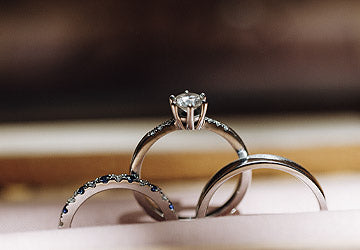Diamonds are one of the most beautiful and popular precious stones on the market. Thanks to their popularity- synthetic, and otherwise lab simulated diamonds have become a major market in themselves. When looking for the perfect diamond, you may come across some of these synthetic diamonds and wonder whether a natural or synthetic lab grown diamond is a better investment and quality. Read on to learn more about the difference between natural and synthetic diamonds and decide what type of diamond will be best for you.
What Are Natural Diamonds?
A natural diamond is created over billions of years deep beneath Earth's surface. When carbon is exposed to extreme pressure and temperature, it is organized into diamonds. Once the diamond has been formed, it can be mined, refined, and turned into the precious glimmering stones we're familiar with. Natural diamonds are just that, a natural occurring stone from within the earth, so flaws and imperfections add to the rarity and characteristics of each diamond.
What are Synthetic Diamonds?
In broad terms, a synthetic diamond is any diamond that was not found naturally. In reality, however, there are a few different categories of non-natural diamonds, and synthetic diamonds make up only one of these. Other types of non-natural diamonds include lab diamonds and simulated diamonds.
Types Of Synthetic DiamondsLab Diamonds
A lab diamond is created under the same conditions as a natural diamond, but in a lab and in an increased timeline. Rather than billions of years, lab-grown diamonds can be created within weeks. These diamonds are then cut and polished, creating a chemically and optically identical diamond to a natural diamond.
Simulated Diamonds
Unlike lab diamonds, simulated diamonds are not chemically identical to natural diamonds. Instead, simulated diamonds are made from similar-looking materials, such as cubic zirconia, moissanite, and white sapphire. We consider simulated diamonds to be synthetic, though some may include lab diamonds in that definition.
Synthetic vs. Natural Diamonds: Which Diamond Is Best?
When choosing between a natural, lab, or simulated diamond, there are many things to consider, including price, durability, and environmental impact.
Price
Because of how long it takes for them to form, natural diamonds are one of the most expensive gems you can buy. If money is an issue, then a lab or simulated diamond is likely a better option. Lab diamonds cost less than natural diamonds while still maintaining the same chemical and optical structure. Simulated diamonds are the cheapest of all, but aren't technically genuine diamonds.
Durability
It's a well-known fact that diamonds are the hardest material known to man. The Mohs Scale of Hardness uses diamond as its 10, and for good reason. However, lab diamonds and simulated diamonds are not as hard as natural diamonds. Lab diamonds measure about a 9.25 on the Mohs Scale, which, though still quite hard, is not as hard as a natural diamond. Simulated diamonds range widely in hardness depending on the material they're made from: cubic zirconia, for instance, rates between 8 and 8.5, while moissanite ranks at 9.25.
Environmental Impact
Natural diamonds must be mined, and mining and refining natural diamonds can have a significant impact on the environment. Lab diamonds and simulated diamonds both avoid these origins, resulting in both a lower cost and a lower environmental impact.
Synthetic vs. Natural Diamonds: Which Will You Choose?
When choosing between real and synthetic diamonds, it is really a personal preference. Several factors can influence which is right for you. If you're interested in learning more about real and synthetic diamonds, contact us today.





